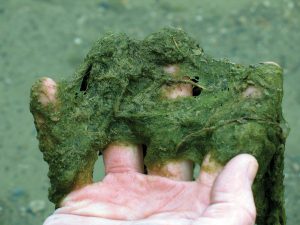 In Florida’s freshwaters, algae are what make the water green. Green water is not necessarily undesirable, and neither are algae. In fact, algae are essential to the ecosystem and to life. A primary component of the food web, algae provide food for all types of animals, including fish, insects, mollusks, zooplankton (microscopic animals), and humans.
In Florida’s freshwaters, algae are what make the water green. Green water is not necessarily undesirable, and neither are algae. In fact, algae are essential to the ecosystem and to life. A primary component of the food web, algae provide food for all types of animals, including fish, insects, mollusks, zooplankton (microscopic animals), and humans.
Algae blooms occur when algae grows quickly and densely, often in warm, nutrient-rich waters. Although these blooms are natural, many people don’t like their appearance. Algae blooms are commonly green, but can appear blue-green, brown, red, or violet. Some blooms can be so dense they actually deplete oxygen levels, and may cause other organisms that use oxygen, such as desirable aquatic plants and fish, to become stressed and/or die.
Copper has been used for many years as a tool for algae control in freshwater farm ponds. The problem with the use of copper is that there is a thin line that separates effective treatment levels from overdoses, which can kill fish. It is important to understand how to use copper and the precautions necessary for effective treatment.
Copper comes in several forms which can be used in water. The cheapest, most common form is copper sulfate, which is available either as a crystal or a powder. Copper sulfate is water soluble, and dissolves fairly easily when mixed with water. Several companies market copper in liquid and crystal forms.
Since the toxicity of copper to fish increases as the total alkalinity decreases, it is necessary to measure the total alkalinity of the water (NOT HARDNESS or pH), before using any copper treatment. A good rule of thumb is to divide the total alkalinity (in parts per million) by 100 to get the concentration of copper sulfate to use in parts per million (1 ppm = 1 milligram/liter). For example, if alkalinity of the water is determined to be 150 ppm, the amount of Copper Sulfate needed would be calculated: 150/100 = 1.5 ppm. 1.5 ppm = 1.5 milligrams/liter.
Florida’s waters are extremely variable in alkalinity, so if the alkalinity of the water is not known, don’t guess. Measure the alkalinity of the water prior to treating with copper. If total alkalinity is less than 50 ppm, copper treatments are not recommended due to the high risk of killing fish. If total alkalinity is over 250 ppm, do not use more than 2.5 ppm of copper sulfate.
Copper sulfate is much heavier than water, and if just thrown into the pond it will sink to the bottom and chemically bind there where it will not have a chance to have an effect on the algae. When using copper sulfate, it should be first dissolved in water. After weighing the amount of copper sulfate needed to treat the pond, mix the copper sulfate in water, making sure that it all dissolves. It is recommended to dilute copper sulfate with as much water as possible and take great care when distributing it, avoiding the creation of areas with higher concentrations, commonly known as “hot spots.”
When using a commercially formulated copper, follow the label instructions for dosage rates. The liquid forms can be applied directly to the water, but it is recommended that they are first mixed with water to dilute them. As with copper sulfate, great care should be taken to evenly disperse commercial formulations over the entire pond area.
In a pond with algae, copper treatments can cause oxygen concentrations to drop, which may result in fish kills. Pond algae are a major source of oxygen production and by removing it, this source of oxygen is also removed. Additionally, oxygen will be consumed as algae decompose. If you are treating to kill algae, either treat in a series of smaller doses over time or have emergency aeration available.
For more information about aquatic weed management visit UF/IFAS Center for Aquatic and Invasive Plants website at http://plants.ifas.ufl.edu
 0
0
